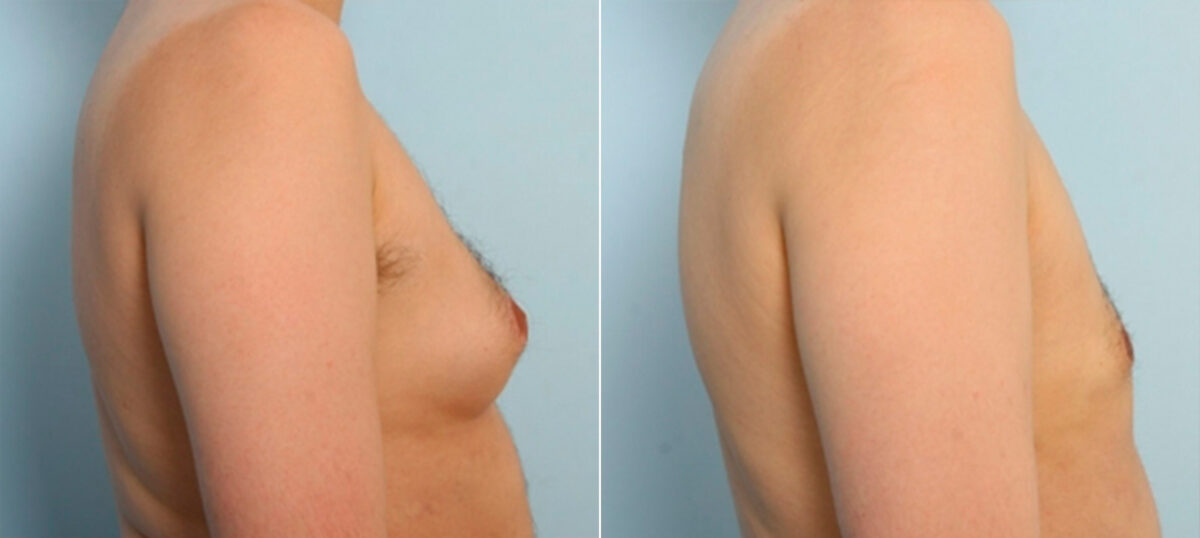Imagine you’re an artist, and you’re trying to distinguish between two shades of blue. They look similar, but each has its unique characteristics. This is akin to distinguishing between gynecomastia and chest fat. Both conditions can lead to an enlarged chest in men, a common condition, but they have different causes and treatments. So, how can you tell the difference? Let’s dive in.

Understanding Gynecomastia
Gynecomastia is a medical condition where glandular tissue in the male breast becomes enlarged, often due to a hormonal imbalance, resulting in the appearance of gynecomastia. It’s like a garden where the flowers have suddenly started to grow uncontrollably due to an overabundance of water. The degree of gynecomastia can vary greatly among patients, with some experiencing a minor increase in breast size while others may develop a more feminine breast contour due to excessive breast tissue.
Symptoms of Gynecomastia
The key factors that indicate gynecomastia include:
- Swollen chest
- Breast tenderness
- Concentric or asymmetric lump felt under the nipple
Understanding Chest Fat
On the other hand, chest fat or pseudo gynecomastia is simply the accumulation of fatty tissue in the chest area. It’s like a room cluttered with excess items, making the space appear larger than it actually is. Unlike gynecomastia, this condition doesn’t carry the risk of gynecomastia, such as the development of glandular breast tissue.
Symptoms of Chest Fat
The signs of excess chest fat include:
- Even the distribution of fat across the chest
- Absence of a firm or rubbery feel under the nipple area
Distinguishing Between Gynecomastia and Chest Fat
Dr. Vitenas, a skilled Board-Certified Plastic Surgeon, can help determine whether you’re dealing with gynecomastia or chest fat during an initial consultation. He will consider your medical history, conduct a physical examination, and may even order some tests to confirm the diagnosis. The extent of surgery needed will depend on whether the patient has gynecomastia or chest fat.
Treatment Options: Gynecomastia Surgery vs. Fat Removal Procedures
Once the diagnosis is clear, the treatment options can be explored. For gynecomastia patients, gynecomastia surgery or breast reduction surgery may be recommended to remove the excess glandular tissue through a surgical excision. This procedure can result in a firmer chest with a more masculine contour.
For those dealing with chest fat, fat removal procedures like liposuction surgery or chest liposuction can be effective. These procedures, often performed as outpatient surgery, aim to remove the excess chest fat, resulting in reduced chest size and improved chest contour.
Preparing for Surgery
Before any cosmetic surgery, it’s crucial to ensure you’re fit for surgery. Dr. Vitenas will assess your overall health, consider any medical conditions, and discuss your lifestyle habits, including alcohol consumption and weight stability. Maintaining healthy body weight and lifestyle can improve the outcome of gynecomastia surgery or fat removal procedures.
Post-surgery expectations
In the weeks and even months after surgery, patients may experience some swelling and discomfort as the healing tissues adapt to their new shape. However, the body after surgery will gradually reveal the results of the procedure, whether it’s a more masculine chest after gynecomastia surgery or a leaner appearance after fat removal procedures. The recovery process is a vital part of achieving the desired result.
Conclusion
Whether it’s gynecomastia or chest fat, understanding the difference is the first step toward choosing the right treatment. Remember, just like an artist distinguishing between shades of blue, it’s all about recognizing the unique characteristics. With the right guidance from a skilled professional like Dr. Vitenas, you can navigate this journey confidently and effectively.
Frequently Asked Questions about Gynecomastia
While a healthy lifestyle can help manage body weight and fat distribution, it may not effectively eliminate gynecomastia, which is caused by enlarged glandular tissue. A consultation with Dr. Vitenas can provide personalized advice.
These procedures are typically performed under anesthesia, so pain during the surgery is minimal. Any post-operative discomfort can be managed with prescribed medications.
Yes, in some cases, gynecomastia can be treated without surgery. Depending on the severity and cause of the condition, treatment may involve lifestyle changes such as diet and exercise or medications to reduce excess breast tissue. Lean patients with milder degrees of gynecomastia may find that reducing fat cells through diet and exercise is effective. However, for more pronounced cases of gynecomastia, surgical treatment may be necessary to achieve desired results.
Recovery can vary, but most patients can return to non-strenuous activities within a week of surgery. Dr. Vitenas will provide a detailed recovery plan tailored to your specific procedure.
The removal of glandular or fatty tissue is permanent. However, significant weight gain, hormonal changes, or certain medical conditions can alter the results. Maintaining a stable weight and healthy lifestyle can help preserve the results.
While gynecomastia itself is not a life-threatening condition, it can sometimes be a sign of other underlying health issues like hormonal imbalances. It’s always important to consult with a healthcare provider if you notice physical changes.

